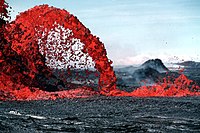
Photo from wikipedia
Rock plucking is the vertical removal of chunks of rock along intersection joint planes by flowing water. The plucking of durable jointed rock in a natural stream alters stream morphology… Click to show full abstract
Rock plucking is the vertical removal of chunks of rock along intersection joint planes by flowing water. The plucking of durable jointed rock in a natural stream alters stream morphology and potentially damages a bridge substructure situated on a rock foundation by local erosion. Despite its importance, the mechanics of bedrock erosion by plucking are not well understood. In this study, we conduct laboratory experiments to investigate the threshold of block entrainment through plucking near a flow obstruction under sub‐critical conditions. In a laboratory flume, we reproduce a wide range of typical lateral flow contraction scenarios that occur around a large rock or bridge substructure and investigate the process of the vertical entrainment of blocks near the obstruction. Two different modes of block removal process (impulsive plucking and accumulative plucking) are observed near the bluff structure. We find that under severe flow contraction, blocks are more likely to escape quickly via impulsive plucking because higher flow contraction and the resulting strong local turbulence around the structure generate large instantaneous uplift force that removes the block within a short period of time; however, we observe accumulative plucking under weaker flow contraction near the bluff structure. From the experimental results, we develop a formula for the threshold point of block dislocation caused by plucking with respect to the degree of lateral flow contraction. The results indicate that increasing the flow contraction ratio reduces block stability because of higher flow acceleration and the increased turbulence effect near the upstream edge of the obstruction. The results of this study should be useful to those who estimate the rate of rock erosion by plucking in natural open channels around a bluff structure.
Journal Title: Earth Surface Processes and Landforms
Year Published: 2021
Link to full text (if available)
Share on Social Media: Sign Up to like & get
recommendations!